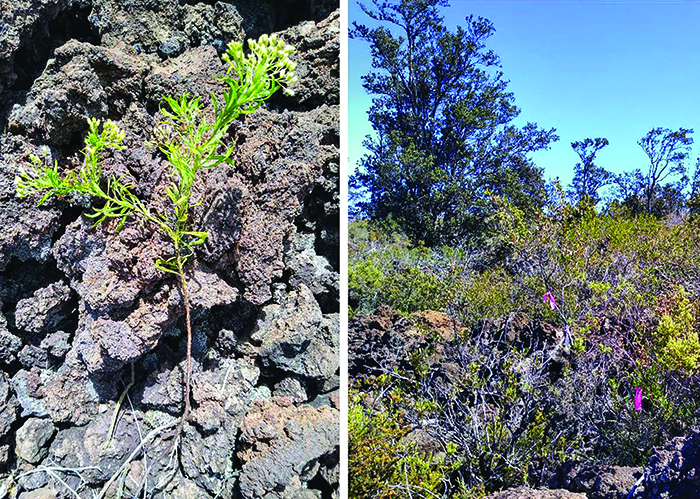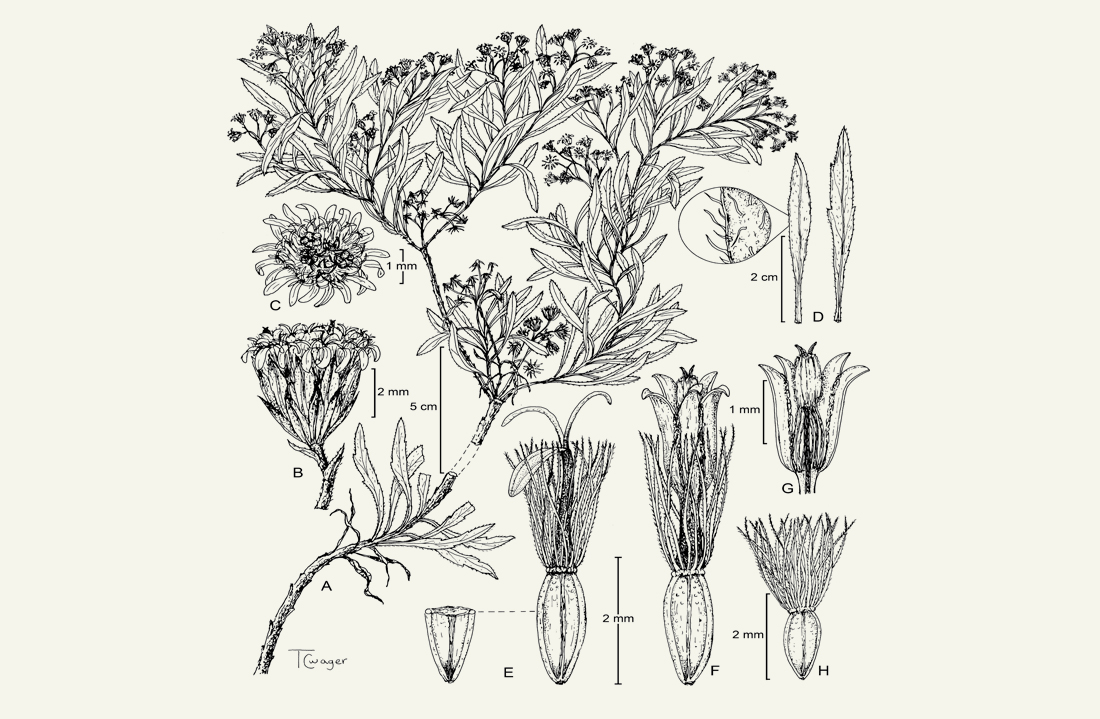BY JODI PETERSON
Hawaiʻi has a newly-recognized species of pamakani, a daisy-like plant. The rare shrub, in the genus Tetramolopium, was first discovered in 1990, but it took nearly 35 years for it to gain scientific recognition and an official name. Scientists from Colorado State University’s Center for Environmental Management of Military Lands and the U.S. Army Garrison Pōhakuloa Training Area worked together over many years on the project, first locating and then scientifically describing the new plant.
Now that the new pamakani has been officially recognized, it will be easier for the Army to track and conserve this imperiled species, which has been found only in a half-dozen populations within the Pōhakuloa Training Area and on Mauna Loa. The PTA, located on a high plateau between Mauna Loa and Mauna Kea on the Island of Hawaiʻi, hosts one of the planet’s rarest habitats. Its tropical, sub-alpine, dryland ecosystem is home to dozens of unusual endemic plants and birds.

Most of the 37 species in the pamakani’s genus are native to the Cook Islands, New Guinea, and Australia, where they grow in native forests or on old lava flows. The plant’s tiny seeds, which have tufted plumes to carry them aloft, are thought to have first reached Hawaiʻi borne by wind currents or birds, where they evolved into several varieties unique to the islands. One of those species, now dubbed Tetramolopium stemmermanniae, was encountered at PTA in 1990 during a CEMML plant survey overseen by Robert Shaw, CEMML’s founder. The survey crew thought it was an extinct species of pamakani, T. lepidotum, but when Shaw later examined a specimen of the white-flowered shrub, he realized that it might be unique. He reached out to Timothy Lowery, an internationally-recognized expert on the genus at the University of Northern Arizona, who agreed that it seemed to be a species not known to science.
In 1997, Shaw and Lowery wrote a technical report titled Rare Plants of Pōhakuloa Training Area that included a description of the new pamakani, which they informally called T. diersingii. However, they didn’t complete the steps necessary for official acceptance, such as writing a Latin description. No further study of the plant occurred for several years, until Steven Evans, who was then a CEMML botanist at PTA, sent samples of it and similar species to the University of Hawaiʻi for genetic analysis. In 2015, that analysis confirmed the plant’s novelty.
Evans set out to collect additional samples and develop an accurate description of the species’ physical and genetic traits. He began the painstaking measurement of various plant parts, many just millimeters long, that was required for official recognition, but quickly felt overwhelmed. “I’m just a field botanist,” Evans said. “I needed help, so I reached out to Nancy (Hastings, a CEMML botanist at the CSU campus). We made a spreadsheet of all the species on the Big Island, then put in our numbers to see if they fell in with the measurements of any similar species.” They didn’t.
Evans proposed that the new species be named in honor of the late Ruth Leilani “Lani” Stemmermann, who worked to preserve the unique plant and animal life of Hawaiʻi. Evans and Hastings collaborated with Cliff Morden and Mitsuko Yorkston from the University of Hawaii, who did the genetic analysis, and Luke Tembrock from CSU’s Department of Agricultural Biology. They co-authored a scientific paper describing the plant, another step toward recognition, which they submitted for peer review in 2021.

Evans oversaw the rest of the necessary steps as well, which included botanical drawings, created by CEMML Graphics Specialist Tracy Wager, and a military legal review, handled by CEMML PTA Senior Program Manager Lena Schnell. Specimens were deposited at four herbaria, including the U.S. National Herbarium at the Smithsonian, another key requirement. The paper was published in the July–September 2023 issue of Systematic Botany, and with that, the new species was official.
Of the long acceptance process, Evans said, “It was nightmarish, very arduous. I am really proud that we finished this and got this plant named after Lani, who was so important to conservation.” Hastings, who has since retired, noted, “It was a team effort. It took all of us to get this done.”
Now, Tetramolopium stemmermanniae joins the 47 other species of rare plants found on PTA. The U.S. Army, which has a strong commitment to preserving the exceptional biodiversity of all of its Hawaiian lands, has contracted with CEMML to help protect PTA’s unique flora and fauna from threats such as wildfire and invasive species. The partnership builds conservation fences to exclude goats, pigs, and sheep from large portions of the training area; works to reduce fire risk; and maintains a greenhouse to grow specimens for transplanting into the wild. So far, more than 350 T. stemmermanniae have been planted, both on and off the installation. “Now that this plant is recognized as a new species, we can seek funding to learn more about its biology and management needs,” said Schnell. “That will help the Army better protect this unique pamakani at PTA.”
 Botanical drawing of the new species of pamakani, Tetramolopium stemmermanniae. Drawing by Tracy Wager.
Botanical drawing of the new species of pamakani, Tetramolopium stemmermanniae. Drawing by Tracy Wager.